solo violin, 1(dbl.Pic).1.1.0/0.1.1.0/2 perc/Pno/hp/4 strings 11110 or 11020
Premiered by MusicNow Ensemble, Chicago Symphony Orchestra, Oliver Knussen conducting, violinist Baird Dodge, 3 April 2006
Duration: 8 minutes
solo saxophone, 1(dbl.Pic).1.1.0/0.1.1.0/2 perc/pno/hp/4 strings 11110 or 11020
Version for saxophone premiered by Ensemble Signal on 7 June 2013 at the June in Buffalo Festival, David Felder, director.
Duration: 8 minutes

![]() BUY SCORE (violin)
BUY SCORE (violin)![]() BUY SCORE (saxophone)
BUY SCORE (saxophone)
![]() RENT SCORE
RENT SCORE
Excerpt 1
Excerpt 2
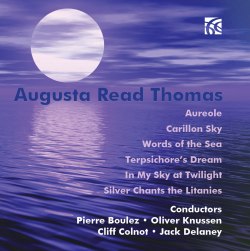
This work is available on
AUGUSTA READ THOMAS - SELECTED WORKS FOR ORCHESTRA
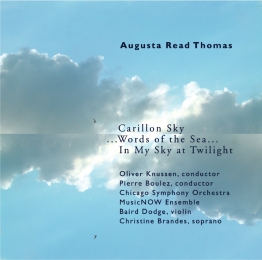
This work is available on
AUGUSTA READ THOMAS - ...Words of the Sea...
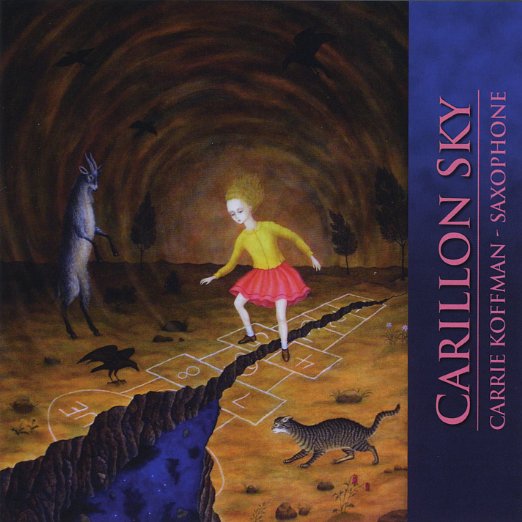
This work is available on CARILLON SKY
Carillon Sky runs from 2:43-3:38
Carillon Sky 2nd violin concerto, Mei-Fang Wang violin solo, University of Illinois New Music Ensemble, conducted by Stephen Taylor
The title Carillon Sky refers to a fantasized image that stimulated me to compose this music — that of a sky full of very soft tinkling and flickering bells, as well as very clamorous pealing, ringing, resonant bells, through which one floats. As if a Cathedral's Bell Tower becomes a metaphor for natures ever changing landscape and the violin soloist is a distinctive bird soaring, interacting, circling and swirling in the resonance. The original working title for this composition was Birds and Bells, since there are many bird-like and bell sounds; but Carillon Sky seemed a more abstract and poetic title upon reflection.
The idea was to try to compose a mini violin concert, but one that is in fact a "whole piece" — all packed into less than 8 minutes. This is like a miniature etching.
The solo violin part is marked with this performance indication: "Passionate and rubato; like a jazz improvisation. Accentuate the variety of characters." Nine bars before the end of the work, there is an option for the soloist to compose and play a short (30 second) cadenza in the style and language of the composition. Trust for the skills and taste of the original soloist, Mr. Baird Dodge, inspired Augusta to allow this option, which recalls the great, deep-rooted tradition of players making cadenzas in concerti.
Made up of several phrases, some of which end on fermatas, the works characters include: majestic, playful, elegant, resonant, spirited, calmly floating, bold, with repose, resolute and graceful. The form is slightly unusual in that the phrases are of asymmetrical length. As if a "group of improvisers" takes the materials a little further "out" or "back in" (in the jazz sense of those words) with each successive phrase. The piece accumulates — rather than being in one of the standard forms, such as ABA form, or rondo form. The form is the best reaction to the objects calling it into being.
Great care was given to the selection of pitches and to the creation of the harmonic fields in this work. I LOVE harmony; and think of my harmonies (simple or rich) as a moving target within a moving target.
It was my intention to bring out much color from the 14-member ensemble.
In the soloist's part, as well as in the ensemble, there are imbedded, in any phrase, other sub-phrases. A kind imbedded-counterpoint emerges with two or three simultaneous lines. For instance, some of the music is made up of long notes and some of short figurations (trills and arabesques) and it is the connection of the two that I find interesting. I like to "write out" the trills because I hear them to have more than 2 notes, to be sporadic in rhythm, and thus, not to be just a simple trill. A highly nuanced figure, with a particular shape and inner life is more interesting to my ears. I use many grace notes. Another example of the imbedded counterpoints comes from the fact that the violin has many different colors, especially from range to range. The lowest register is rich, dark and haunting, while the very top range is trumpet-like, brilliant and shimmering. Springing back and forth between different registers, and with contrasting dynamics, gives the sensation that more than one voice is in play and that somehow the truth of the piece is in the crossways between the various intersections.
While the music was very carefully made, and is highly nuanced, and is a "serious" piece of music, it should sound free, spontaneous, resonant, jazzy, playful and alive.
—Augusta Read Thomas
John von Rhein, Chicago Tribune (2017)
“‘Carillon Sky,’ a bracing mini-violin concerto that received its premiere on the series in 2006, was reprised with Dodge again assuming the solo duties with poetic panache. His violin soared through a soundscape tingling with luminous and clangorous bells, traversing vast sonic spaces in just under seven minutes.”
Lawrence A. Johnson, Chicago Classical Review
“Augusta Read Thomas held the CSO’s composer in residence post for nine years, a record unlikely to be broken anytime soon. Violinist Dodge reprised his 2006 world premiere of Thomas’s Carillon Sky, a compact chamber concerto. Dodge gave fine advocacy to Thomas’s restless solo lines conveying her intention of creating a ‘captured improvisation’.”
John von Rhein, Chicago Tribune
"This is the final season of MusicNOW concerts to be curated by Augusta Read Thomas, the Chicago Symphony Orchestra's tireless composer-in-residence and an inspirational force behind the series from its inception.
"She has done a remarkably thorough job of it, bringing local audiences a great deal of new music in a wide variety of styles they would not ordinarily have been exposed to. By entrusting this music to musicians from the CSO under principal conductor Cliff Colnot and a host of guest composer-conductors, she also has ensured performances at the highest level of skill and commitment. Of how many concerts of contemporary music can that be said?
""Gusty" Thomas signed off on the series Monday night in Orchestra Hall with a generous program that included two world premieres — her own Carillon Sky (2005) and Oliver Knussen's "Requiem — Songs for Sue" (2005-06), a MusicNOW commission.
"Baird Dodge dispatched the piece beautifully as the featured violin solo in Carillon Sky, Thomas' "thank-you" to the entire CSO family. The title suggests the image of a sky full of pealing bells and chirping birds. The violin shifts expressive character like a musical chameleon, nestling in the delicate scoring for 13 instruments before improvising a cadenza.
"The music, not to mention Dodge's playing, was so engrossing that I wished Thomas had developed her materials at greater length. Maybe she will somewhere down the line."
Wynne Delacoma, Chicago Sun Times
"Sheer beauty of sound is not always a byproduct of contemporary chamber music performances, but it was front and center at the MusicNOW concert Monday night in Symphony Center.
"Now in her ninth and final season as the Chicago Symphony Orchestra's composer-in-residence, Augusta Read Thomas has been one of the guiding spirits behind the CSO's increasingly solid MusicNOW series. Her taste is eclectic. As she said in introductory remarks Monday night, "MusicNOW has no house style.''
"Thomas' world premiere, Carillon Sky for Dodge's solo violin and small ensemble, was full of her typical sensitivity to musical color. Dodge's violin was sweet-toned but assertive, dancing in and out of conversation with the accompanying ensemble."
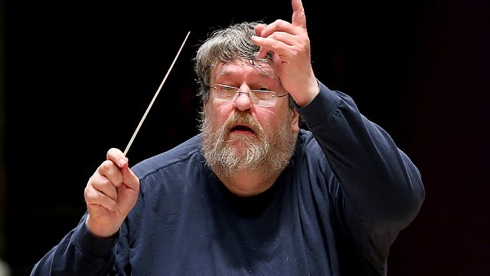
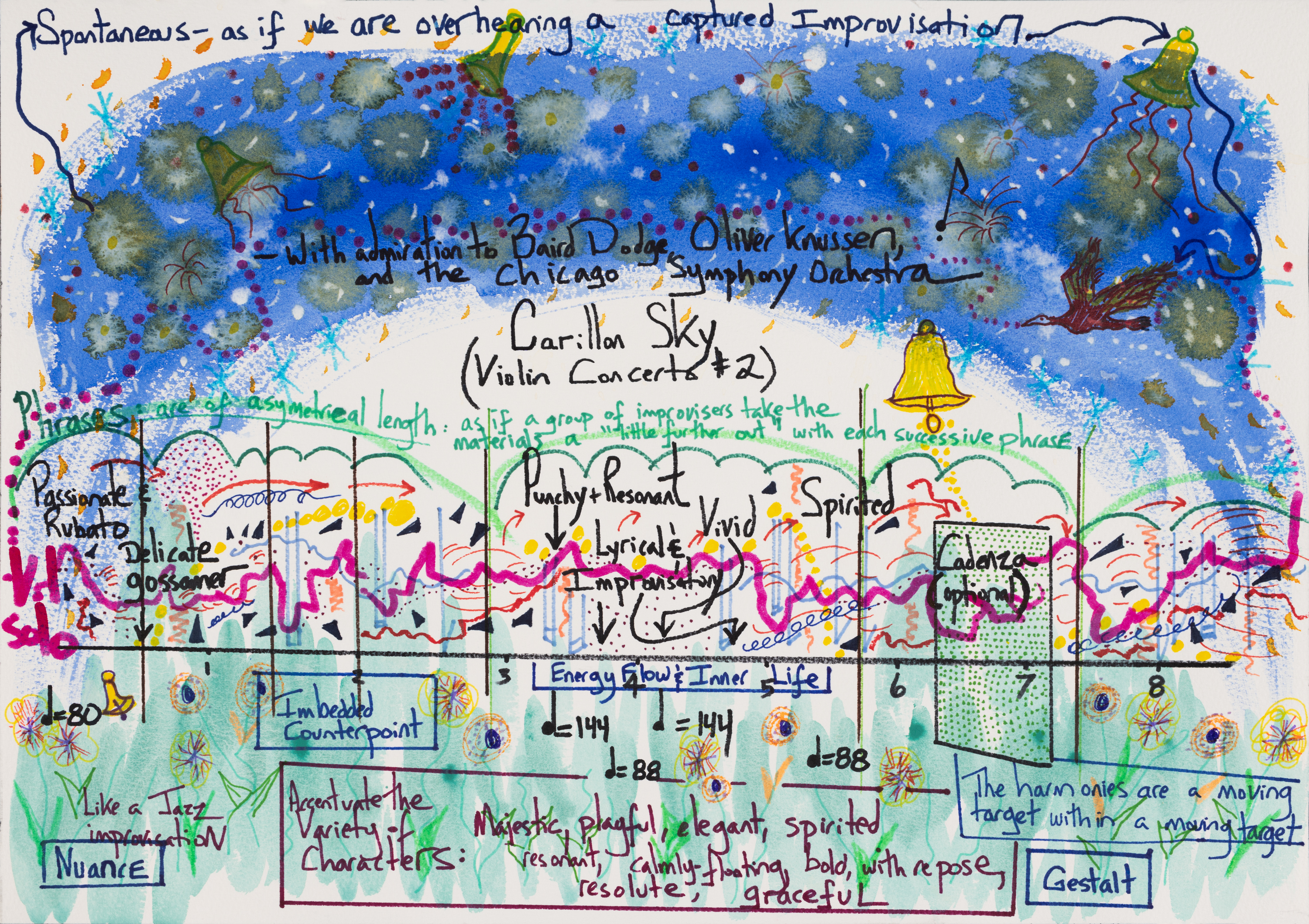
To obtain examination or performance material for any of
Augusta Read Thomas's works, please contact G. Schirmer Inc..
